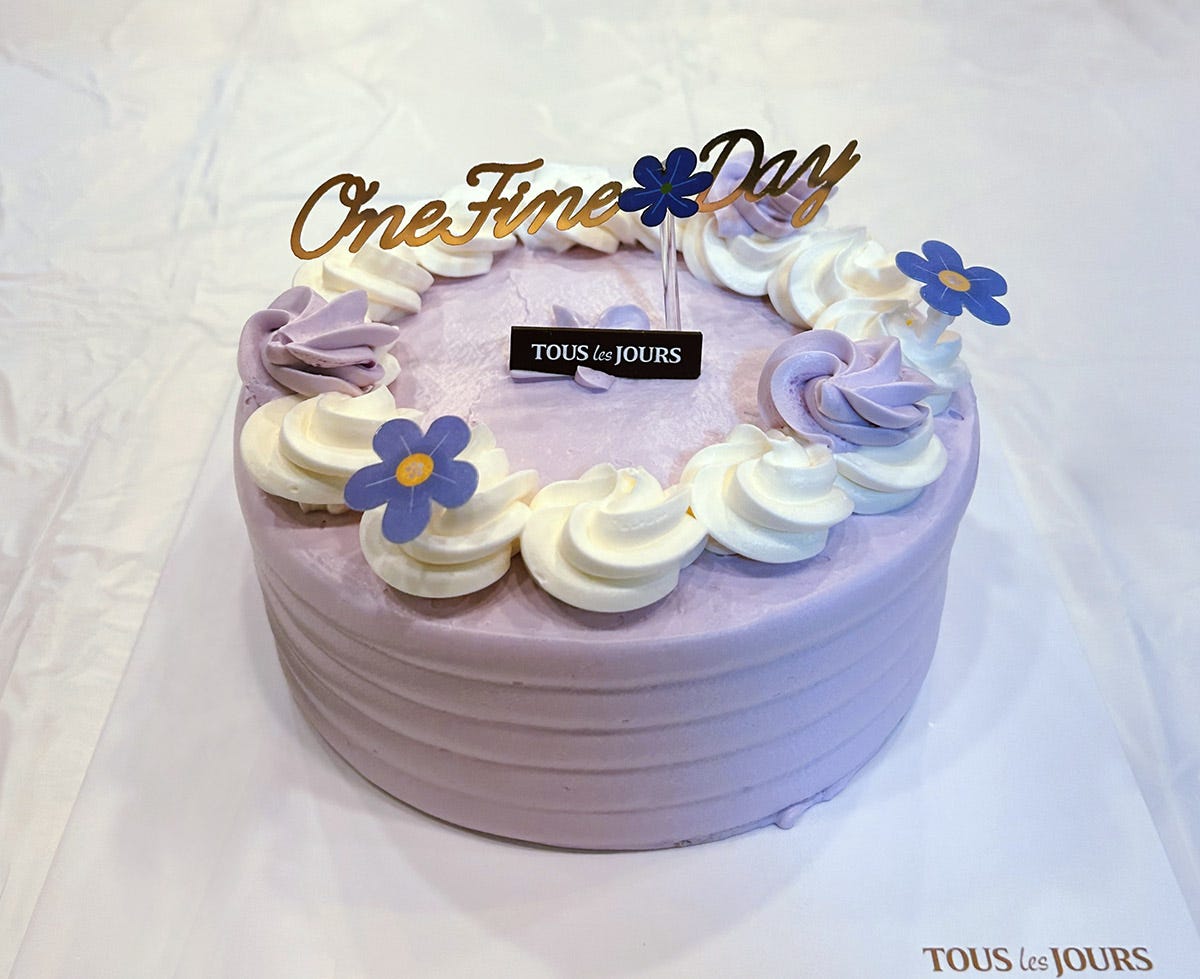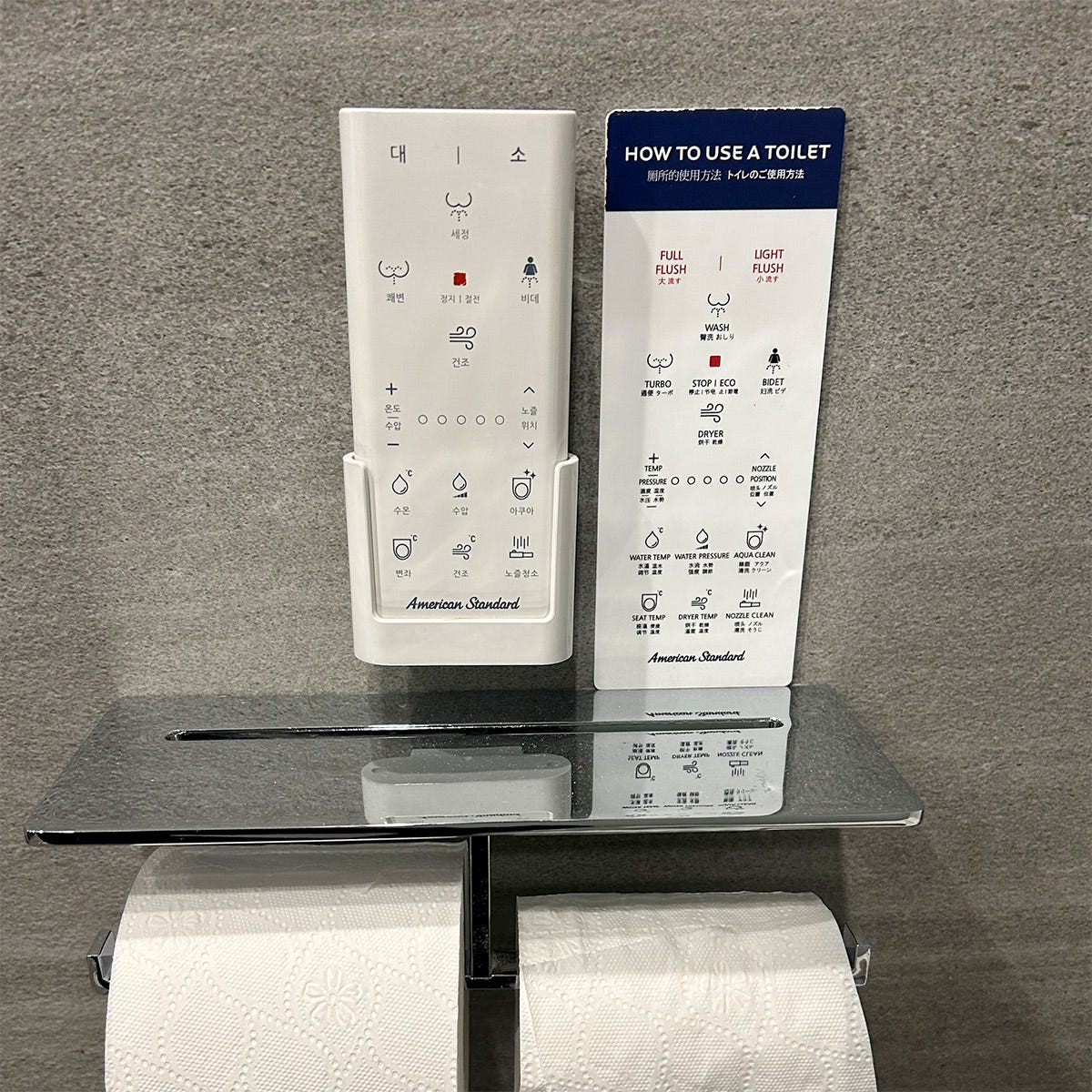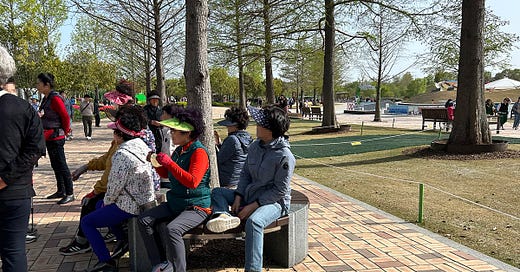Age fluidity, bathroom habits, and the fabulous fashions of Korean ajummas
Travels with my mother pt 2.
Age fluid
“How old do you think he is?” I whisper to my cousin as we listen to our tour guide tell the story of the heroine depicted on a painting in a shrine at one of our many sightseeing stops traveling around Korea.
“Maybe our age? Maybe a little older,” she whispers back. “No, wait. He could be younger than us, actually. I just never assume anyone is older than me anymore.”
In a classic case of “can’t tell how old that Asian is 🤷🏻♀️,” one of the many running themes during my recent trip to Korea was that nobody in our various tour groups knew how old anybody was. This is a meme I referenced in an essay about aging I wrote a few months back, and of currently being in the very weird transitional stage between looking eternally young to all of a sudden blooming into an Asian grandma.
In Korea, it’s not actually impolite to ask someone you’ve just met how old they are because of the use of honorifics in the language; knowing a person’s age is central to how you address and converse with them. Our tour group was comprised of mostly older Korean Americans from the States though, so age didn’t readily come into our conversations, but I happened to have a birthday while I was traveling. A cake was purchased and the birthday song was sung. The tour guide in question did turn out to be almost exactly the same age as me, but he was shocked to learn that my cousin and I were in our early 50s just like him.

50s. It still feels so weird to type this out and see the number in writing. I mentioned in that same newsletter how I’ve always been rather cagey about my age because I wanted to protect my hireability in an industry that is notoriously ageist. I always thought that if I could look eternally 40s and vaguely youngish during the time I have left in tech/design, I’d hopefully cheat my way out of dealing with ageism altogether. But now that I’ve decided to finally transition out of the industry, there’s no need to be cagey about how old I am anymore.
This feels refreshingly liberating! But also weird? Because when I hear 50s, I still have a mental model of my mother and her mother, both of whom were about my age, give or take a few years, when they became grandmothers. Yikes. I am definitely not ready for that! But I’m realizing that since turning 50 at the height of the pandemic when time was so surreal and hanging in a suspended state to begin with, I’m still trying to sort out what being in my 50s means, even though I’ve been living it for a couple of years already now. It’s very much a liminal age between young and old.
During our trip, my mom and I were mistaken for being sisters, but also grandmother/granddaughter. Our ages became hilariously fluid. Everyone we met assumed my cousin and I were younger than we were and as the trip progressed, we just kept getting younger and younger. People were shocked I had a college-aged kid, and I was stunned when someone I assumed was in her mid-40s turned out to actually be 60. A fellow traveller (who was my age, as we later found out) confessed that she thought my cousin and I were high school students at one point and wondered how we could be missing so much school.
Lol.
I assure you, we do not look anything like high schoolers. But we did wear masks most of the time because the air quality from the Yellow Dust that migrates into Korea every spring was so bad (the AQI was over 400 some days), so maybe from afar or behind that was plausible. It did make me wonder why we were perceived as younger than we were, particularly since we were often covered up with masks and hats. Was it the way we dressed? Was it because we traveled without spouses or children? Was it because we were one of the few traveling with our mothers?
Nothing is too TMI for Koreans
My cousin and I might have been among the youngest of our traveling group of (mostly) seniors on our guided road trip through the country, but we were old enough to commiserate in daily conversations about the various ailments that plagued us, the most common being small bladders, constipation, and forgetfulness.
Nothing is too TMI among Korean strangers, apparently, and every morning the women would discuss how the changes in our eating habits and routines during this time of travel messed with our metabolisms. The food just did not move—sometimes not for days. We’d complain about how bloated we felt after having rice everyday and would check in with each other about the progress of our constipation struggles. I know we’re a culture of rice eaters—and I love white rice, especially with a fried egg on top (my ultimate comfort food), but I can’t eat it everyday anymore like my teenagers can.
There is no such thing as too many bathroom breaks
Public bathrooms in South Korea are plentiful and you generally do not have to worry about finding one, but I guess our American selves were so accustomed to scanning the location of restrooms everywhere we went, that we couldn’t stop ourselves from making a beeline to the bathroom every time we saw one. I know I do that here in America for fear of passing up a clean(ish) bathroom when I’m out and later feeling the pangs of regret if I didn’t seize the opportunity. But this wasn’t necessary in Korea.
But even so, we went to the bathroom all the time. It was the first thing we did when we arrived at our destination. We’d go again before and sometimes after every meal, and it was our most important stop before boarding our vehicle again. Even if we didn’t really have to go, we went anyway because why the hell not—a bathroom was available! I don’t think I’ve ever gone to the bathroom as frequently in the course of a day as I did during my time there. The frequent bathroom visits greatly perplexed one of our tour guides who was a young millennial in her early 30s. When some of the women gently lectured her about the importance of pointing out to old folks where the bathrooms were as soon as we arrived at our destination, our tour guide never made the mistake of failing to point out the nearest restroom again.
It got so ridiculous that at one point, one of the women announced that we needed an intervention. She reminded us that our bodies were getting used to going to to the bathroom so frequently that we needed to retrain ourselves to hold it in longer, otherwise it wouldn’t know what to do if we ever found ourselves in a situation where a bathroom couldn’t be found. We promised that we would discourage each other from taking unnecessary restroom trips. Surely we would be screwed when we came back to America if we didn’t correct our overzealous bathroom habits.

Where are the men and children?
It’s strange, but when I think back on my trip now, it seems like South Korea is a country comprised of mostly middle-aged and elderly women. This isn’t true, of course, but I rarely saw any kids on my trip and it seemed like I was always surrounded by women, particularly outside of Seoul. What is true is that the country has the lowest fertility rate in the world. None of my younger cousins in Korea have children and they don’t intend to either.
With women statistically outliving their spouses, the absence of senior men was glaringly noticeable. There were just so few around even in our own tour group, and all of my aunts in Korea are widows. We happened to be visiting a popular garden attraction called Suncheon Bay Gardens on a day there was free admission for senior citizens and the place was flooded by older Koreans. We got caught in a long line waiting for the tram and got swallowed by a sea of Korean ajummas.1 I’ve only ever experienced “the ajumma” here in the U.S., but being able to observe ajumma fashion in its native country of origin for an hour in line was probably one of the most entertaining moments of my trip.
An ajumma fashion show
My cousin and I marveled at all the different colors and patterns we saw mixed so casually in a single outfit, the affinity for bright and neon colors, and the preference for pants, always—never saw a skirt or a dress on a woman older than 20s or 30s. On the feet were sneakers and other sensible shoes. But the three things that most of the women had in common? Visors, scarves, and gloves. We saw visors with brims as wide as the floppiest Southern belle sunhat; we saw them with additional side flaps of fabric that covered the ears; we saw ones made of straw, ones made with fabric, and others in see-through vinyl in bright colors. We even saw a mega visor with two smaller visors on either side.
On necks, the women wore scarves, always expertly knotted. Sometimes they complimented the outfits with a fresh pop of color, but other times they clashed with the floral patterns of their tops. Their penchant for mixing patterns so boldly and carefree was admirable. But the thing that was new to us, the takeaway about ajumma fashion that we learned from our time in Korea, was the gloves. The weather was warm, but so many ajummas that we saw that day wore gloves, sometimes fingerless.
“What do you think the gloves are about,” we theorized with each other when we realized just how common they were. We’ve certainly never seen gloves worn in this manner before, not in summer and not like these. They came in every variety: cotton, nylon, flesh colored, patterned, sporty. Some of them looked like driving or golfing gloves, but others were trimmed in lace or sewn with delicate, sheer panels.
Later, we realized that gloves are worn as a protective layer from the sun and other aging elements. Of course! No matter how young a person’s face looks, the neck and hands are often a dead giveaway to a person’s real age, hence the scarves and gloves. Genius!! We vowed to track some down ourselves and when we found fingerless, semi-sheer pairs from a street vendor back in Seoul, we bought them immediately. They threw us back to the 80s circa “Desperately Seeking Susan.” Win win.
It’s all fun and games until you’ve fallen yourself and can’t get up
If you’re GenX or older, then you’ll remember that medical alert device commercial about the elderly woman who’s fallen, but can’t get up. Last Monday, over a week ago, it happened to me. It was a stupid accident and I’m paying the price. My ribs crashed into a chair on my way down to the floor and I twisted my ankle, which is why I had a difficult time getting up. Turns out that I probably have something called intercostal muscle strain in my ribs and possibly fractured a rib or two, which I have had before. These take forever to heal.
The muscle strain weirdly feels like a pregnancy contraction, but in my ribs (WTF) and it happens frequently depending on which way I move. It can take me up to 20 minutes in carefully slow incremental movements to get up from a reclining position.
“You sound like you’re having a contraction. It’s the same noise you made when you were in labor,” Mark observes.
Gee, thanks.
On the day the fall happened, my younger kid fed me lunch as I recovered in bed, unable to move without great pain. I told her that this felt like a future snapshot of how we might find ourselves 30 years from now when I’m super old and she’s feeding me apple sauce when I’m no longer able to swallow solid food.
She scowled at me in the same way I used to when my mom would corner me to discuss the contents of her will years ago.
Don’t stand on unstable chairs, kids.
An ajumma, as a reminder, is what Koreans used to call a middle-aged married women. So I had heard that the word is no longer used anymore in Korea because it’s now considered a bit of an insult. I guess this is true because I didn’t hear the word at all during my trip.






Aging, thank you for these posts.
I had frozen shoulder last winter (google it, it’s apparently common in post-menopausal women: NO ONE REALLY KNOWS WHY. But I digress.)
Was doing PT and one day ended up with a new tech who clearly hadn’t read my chart but seemed to be trying to figure me/my issue out. Did I recently have surgery? Been in a car accident? Had I injured myself? Etc etc it goes on. Finally my age came up (56) and it was hilarious how the questions stopped. No longer was it curious why I was having such pain; my age (shrug) was the reason of course.